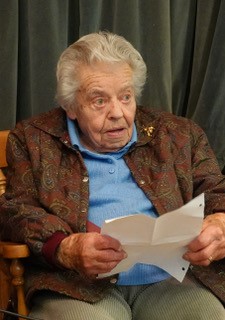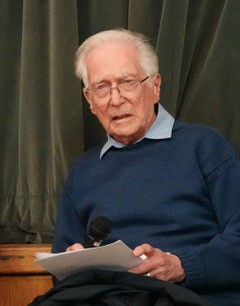Denton in World War Two
Apart from those Denton residents who saw active war service (details of the one man who, sadly, did not return are recorded in our War Memorial page), there were two specific ways that the war impacted (no pun intended) the village.
We also record the wartime memories of two residents, and details of how the 80th anniversaries of VE Day and VJ Day were celebrated.
The Norfolk Aircraft Carrier
Following the United States' entry into the war late in 1941, East Anglia found itself rapidly covered by a large number of US Army Air Force bases. There were over 20 in Norfolk alone. The nearest to Denton was Hardwick, just across the parish boundary in Topcroft and Hempnall parishes. There, from September 1942, first B25 Mitchell medium bombers and then B24 Liberator heavy bombers conducted daylight bombing missions. But there were other US bases not very far away at Seething, Flixton and Thorpe Abbots.
Hardwick was Station 104 of the US Army Air Force and home to their 93rd Bombing Group. The Group's museum is still located in a group of war-time nissen huts on the site of the airfield in Topcroft. A lot more information about the Group and the airfield can be found on the Museum Website.
First there was the disruption caused by the loss of farming land and the construction of the bases. Then the challenge of supplying and supporting the bases and their personnel.
In order to dispurse bomb storage areas a network of concrete tracks were constructed mainly in Earsham. Most of them still exist today.
The site where the tracks branch off the Denton to Earsham Road was given an unusual name. It seems a US serviceman turned up there for the first time and said "Gee, it's just like Catalina Creek!", a reference to his home area in the USA. The name has stuck.
The arrival of thousands of, predominantly young male, US servicemen must have had a considerable impact on the local social scene. Some details of how Denton handled this situation appear on the Brief History page.
Disaster Averted
As noted above, the Denton area was involved in a vital aspect of supporting the US airfields, providing areas to store the munitions they used. On the East side of the village a network of concrete tracks and pads were constructed for this purpose - they are still there.
Thousands of tons of bombs were unloaded from goods trains in the railway sidings at at Earsham and then stored on the concrete pads before being taken to the local airfields.
One incident that occured towards the end of the war has gone down in local history. On July 6th 1945 a US Army convoy was transporting a batch of cluster bombs in boxes away from the sidings.
As one of the lorries was using the level-crossing over the main line some boxes fell off. The next lorry had to brake sharply and its load fell onto the line itself.
Mrs Violet Hewitt, the Crossing Keeper, realising that a train was approaching which could cause a major explosion if it hit the boxes, bravely ran down the line waving a red flag to stop the train, just in time,
She was awarded the LNER (London & North-Eastern Railway) Medal for her outstanding "Bravery and Resource".
(This incident was reported in the EDP on May 16th 2025).
Two Near Misses
There is no record of any bombs being dropped in the neighbourhood of Denton during the war. By the time the nearby airfields, which might have attracted enemy interest, had been built the ability of the Luftwaffe to mount bombing raids was much diminished. However, for a very brief period in 1944 a much more terrifying weapon threatened the village.
Very few V1, "Doodlebug", Flying Bombs, were launched against Norfolk, many more fell on Suffolk. But one did land, on 9th October 1944, at Thwaite St Mary, Grid Ref. TM 336-954, causing minor damage to some houses and the church.
In September 1944 NAZI Germany revealed its new "terror" weapon to succeed the V1. Medium range ballistic missiles - V2 rockets - were launched for the first time. Fired from mobile launch sites in Belgium and the Netherlands and carrying a one ton warhead, the initial targets were London and Paris.
The first rockets were launched on September 8th. Later in the month the only other major British towns within range, Norwich and Ipswich, were added to the list. Between 26th September and 12th October 43 V2s, launched from Rijsterbos in the Netherlands, hit Norfolk.
The guidance system for the rockets was very primitive so only three of the rockets aimed at Norwich actually exploded in the city. The rest landed over a wide area of the county including two in this area.
- On October 1st in the early evening a rocket hit Sycamore Farm at Bedingham just north of Denton, Grid Ref. TM 2785-9090, creating a crater 9 metres wide and 1.5 metres deep. The farm buildings were damaged and four people injured. The site was close to the base hospital of the nearby Hardwick US Airforce base.
- During the evening of October 3rd a second rocket fell locally, this time just in Denton itself. It landed in a field just west of Darrow Farm right on the boundary with Alburgh and created a large crater. This has since been used as a rubbish pit and is now difficult to spot. It is next to a stile on the footpath between Darrow Green Road and Broad Road at Grid Ref. TM 2585-8925. For some reason it seems there was a delay of about 10 minutes before the warhead exploded; some damage was caused but there were no casualties.
A much more impressive V2 crater, created on October 6th, can be see next to a bridleway just South of Shotesham Church, Grid Ref. TM 2465-9899.
Unlike bombing raids or even the earlier V1 attacks, the V2s, travelling faster than the speed of sound, gave no warning of their approach. There was no chance of anyone seeking shelter. They really were terror weapons. Luckily for Norfolk, by the middle of October the advance of the Allied forces from Normandy had forced the German NAZIs to switch targets to the key port of Antwerp, though launches against London continued. Then the NAZIs were forced to retreat into Germany itself and London was out of range. The last V2, of the 3,172 used, was launched on 28th March 1945.
A comprehensive record of the V2 campaign is available from the V2 Rocket Website.
VE Day Memories
As recorded in the June 2025 edition of the Parish Magazine.
In May 2025 Denton residents gathered at the Village Hall to commemorate the 80th Anniversary of VE Day the end of the war in Europe.
Part of the highlights were speeches from two of our oldest residents. Hilda Thomas and Robin Limmer gave us graphic insights of their experiences of the War.
They were both gripping, in the stories they told and the way they told them. These are shortened versions of what they told us.
Hilda’s Wartime Memories

3rd September 1939: Within a day or two of being told by Mr Chamberlain ‘We are now at war with Germany’, we had to be fitted with gas masks and collect our ration books as food soon became scarce.
We were encouraged to dig up our gardens to grow vegetables and in the countryside hedges were taken out and ditches filled in to make bigger fields.
The ration for one person per week was 1oz butter, 4oz margarine, 1pt milk, 1 egg. Tea, sugar, cheese, meat and later bread were all rationed. Country people faired a bit better as most people had a few hens and there were also rabbits to catch.
My dad and brother dug an air raid shelter in our back garden and made shutters for all the windows.
1940: The triumph and tragedy of Dunkirk, those who got away and those who did not. The success of the Battle of Britain.
1944: The 'D' day landings. Vera Lynn kept our spirits up with 'We'll meet again'.
May 8th VE Day 1945: We all went wild with street parties, Church bells ringing and dancing.
Food rationing gradually receded and finally finished in 1954, 9 years after the war ended.
Robin’s Wartime Memories

Mother and I were air-raid sheltering in the cupboard under-the-stairs on January 3rd, 1945, at Broome, my birth village, when the sinister snarl of a Doodlebug cut out overhead. We waited to be blown up......and waited..... After an eternity (probably 12 seconds!) it roared back to life and continued its evil way - via Denton - to Topcroft - the last Doodlebug to crash on Norfolk.
In September, 1942, a Spitfire plunged in flames on Broome Heath, narrowly missing our house. Its Canadian pilot, from RAF Ludham, perished in the wreckage. I was at the tragic scene.
The Waveney Valley was vulnerable to the Luftwaffe, with five airfields: Flixton, Hardwick, Seething, Thorpe Abbotts and Ellough.
On October 1st, 1943, a V2 rocket hit Sycamore Farm, Bedingham, four people injured and taken to Hardwick US base hospital. On the 3rd, another hit a field west of Darrow Green Farm.
At Bungay Grammar School, beneath the flight path of the Liberator and Mitchell-based Flixton airfield, we dived under our desks when short whistle blasts indicated Nazi aircraft above, while a long burst sent everyone outside to the shelters!
Later in the evening tributes were paid to the many who had lost their lives during the war, one of many Beacons across the land was lit and ‘I vow to me my country’ was sung with pride by all those who attended the anniversary.
![]()
VJ Day Celebrations
Following VE Day in May, the 80th anniversary of the final act in the War, the surrender of Japan, followed on August 15th.
Denton celebrated this with an appropriate gathering on the Playing Field.
Details can be found in a News item from August 25.